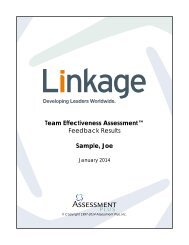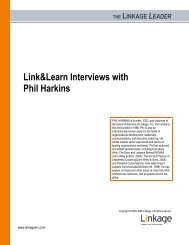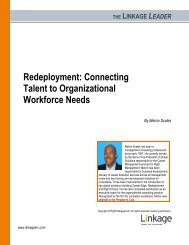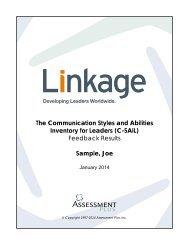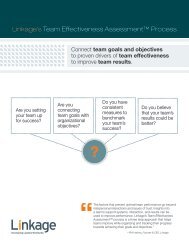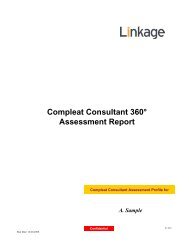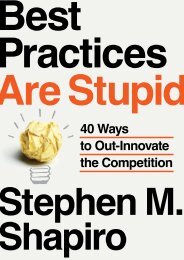HiPlay Team Assessment Feedback Results Sample ... - Linkage, Inc.
HiPlay Team Assessment Feedback Results Sample ... - Linkage, Inc.
HiPlay Team Assessment Feedback Results Sample ... - Linkage, Inc.
You also want an ePaper? Increase the reach of your titles
YUMPU automatically turns print PDFs into web optimized ePapers that Google loves.
Second, the instrument contains items derived directly from the many years of small groupresearch that has been done in academic social psychology. For example, academicresearchers discovered years ago that effective problem-solving teams tend to differentiate twomajor roles that are key to success—the formal task leader and the socio-emotional processleader. That finding is included under the “Flexible Structure” scale of the HiPLAY assessment.Others discovered that the “norms” that emerge in teams as the result of interaction on a taskexert a significant impact on the formation of team relationships, on what gets talked about inteam meetings (and what doesn’t), and ultimately on how productive the team is over time. Stillothers found that the way in which power and leadership are manifested in teams can have asignificant impact on results. Many of these conclusions from academic research are embodiedin the “Rules” and “Organization” factors of the HiPLAY assessment.One particularly crucial source of academic research that has affected the design of HiPLAY isthe work of Bales, Williamson and Cohen (1979) resulting in SYMLOG (A System for theMultiple Level Observation of Groups). Based upon nearly forty years of observational researchat Harvard, SYMLOG is both a theory and a set of tools for measuring the “field of forces” in ateam which arise from the behavior and conversational content of teams at work. SYMLOGmay be the only tool available that can actually measure “fields” as Kurt Lewin talked aboutthem over 50 years ago. Bales and his colleagues found (through thousands of factor analysesof behavioral observations, value statements, and non-verbal expressions) that the adjectivesused to describe these “social fields” can be arrayed along three highly robust factors: (1) theorientation towards the use of power and impact; (2) the orientation towards expression ofaffect in relationship and conflict; and (3) the orientation towards authority, control and freedomaround the task. The language of these three factors—which, for simplicity, can be called thefactors of Power, Relationship and Action—lies at the heart of the “Rules” framework, andcontributes to a definition of the “Commitments” scale of the “Competencies” factor. Thefindings from over one million users of SYMLOG regarding the behaviors and values of highlyeffective team leaders and teams are also factored into many of the items throughout theHiPLAY instrument.A third major origin of the HiPLAY assessment is the work that has been done, primarily bypractitioners, on the design and use of “competency models.” Robert White was probably thefirst to use the term competency in his treatise on competence motivation in 1959, but it wasDavid McClelland who gave the term its current popularity as a result of his claim in 1973 thatmany psychological measurements simply were not useful in predicting effectiveness in worksettings. He saw a competency as an underlying pattern of thinking, emotion, motives, values,or self-concept that drives behavior, differentiating highly successful people in particular workfrom the rest. While McClelland and his followers applied the concept only to individuals, thereare those who are now attempting to apply the concept to team, or even organizationalcompetency. The HiPLAY framework assumes that competency is a description of anindividual characteristic or behavior that contributes to team success—not a description of theteam as a whole.





